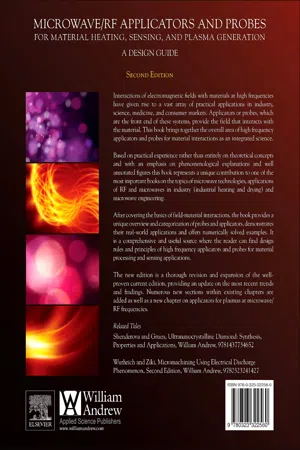
Microwave/RF Applicators and Probes
for Material Heating, Sensing, and Plasma Generation
- 440 pages
- English
- ePUB (mobile friendly)
- Available on iOS & Android
Microwave/RF Applicators and Probes
for Material Heating, Sensing, and Plasma Generation
About this book
Microwave/RF Applicators and Probes for Material Heating, Sensing, and Plasma Generation, Second Edition, encompasses the area of high-frequency applicators and probes for material interactions as an integrated science.Based on practical experience rather than entirely on theoretical concepts, and emphasizing phenomenological explanations and well-annotated figures, the book represents one of the most important resources on the topics of microwave technologies, applications of RF and microwaves in industry (industrial heating and drying), and microwave engineering.After covering the basics of field-material interactions, the book reviews and categorizes probes and applicators, demonstrates their real-world applications, and offers numerically solved examples.Readers will find valuable design rules and principles of high-frequency applicators and probes for material processing and sensing applications in this expanded edition.- Presents new information on how the interactions of electromagnetic fields with materials at high frequencies have given rise to a vast array of practical applications in industry, science, medicine, and consumer markets- Thoroughly revised and expanded edition, providing an update on the most recent trends and findings- Contains many new sections within existing chapters, along with new chapters on applicators for plasmas at microwave/RF frequencies
Frequently asked questions
- Essential is ideal for learners and professionals who enjoy exploring a wide range of subjects. Access the Essential Library with 800,000+ trusted titles and best-sellers across business, personal growth, and the humanities. Includes unlimited reading time and Standard Read Aloud voice.
- Complete: Perfect for advanced learners and researchers needing full, unrestricted access. Unlock 1.4M+ books across hundreds of subjects, including academic and specialized titles. The Complete Plan also includes advanced features like Premium Read Aloud and Research Assistant.
Please note we cannot support devices running on iOS 13 and Android 7 or earlier. Learn more about using the app.
Information
The impact of fields on materials at microwave and radio frequencies
Keywords
Introduction
Table of contents
- Cover image
- Title page
- Table of Contents
- Copyright
- Dedication
- Preface
- Acknowledgments
- Introduction
- Chapter 1. The impact of fields on materials at microwave and radio frequencies
- Chapter 2. Fundamentals of field applicators and probes at radiofrequencies and microwave frequencies
- Chapter 3. Electric field (capacitive) applicators/probes
- Chapter 4. Single-mode microwave cavities for material processing and sensing
- Chapter 5. Microwave multimode cavities for material heating
- Chapter 6. Applicators and probes based on the open end of microwave transmission lines
- Chapter 7. Magnetic field and inductive applicators and probes at high frequencies
- Chapter 8. RF/microwave applicators and systems for joining and bonding of materials
- Chapter 9. Design considerations for applicators in continuous-flow microwave/radio frequency processing
- Chapter 10. Plasma applicators at RF and microwave frequencies
- Appendix A2.1. Mode chart for cylindrical cavities
- Appendix A2.2. Human safety regulations on maximum exposure to electromagnetic fields at high frequencies
- Appendix A2.3. Frequency allocations for industrial, scientific, and medical (ISM) applications
- Appendix A3.1. Impedance/Admittance and electric field solutions for a parallel-plate applicator with dual layers of real dielectric materials
- Appendix A3.2. Mathematica™ worksheet for derivation of dual-layer parallel plates with real dielectrics
- Appendix A4.1. Field analysis of TM0n0 cylindrical cavities with two concentric layers of real dielectric at the axis
- Appendix A4.2. Mathematica™ Notebook for Computation of Single-mode TM0n0 Cavities for Material Heating and Sensing Applications
- Appendix A5.1. Analysis of an Example of Rectangular Cavity Mode for Power Density
- Appendix A5.2. Mathematica™ Notebook for Computation of Possible Modes Over a Given Bandwidth for a Rectangular Multimode Cavity
- Appendix A6.1. Mathematica Worksheet for Finding the Admittance and Equivalent Circuit Parameters of the Open-ended Coaxial Probe
- Appendix A6.2. Mathematica™ Notebook for Impedance of the Extended Center Conductor Coaxial Line
- Appendix A6.3. Admittance of Open-ended Waveguide with Dielectric Material Loading
- Appendix A7.1. Field Analysis of Circular Loop Applicator
- Appendix A7.2. Mathematica™ Program for Eddy Current Induction Into a Conductive Cylinder
- Index